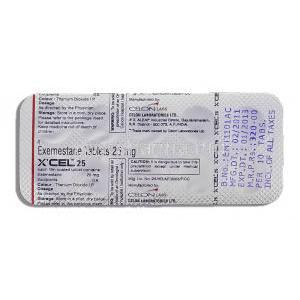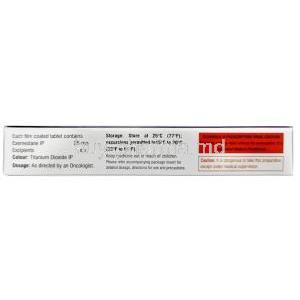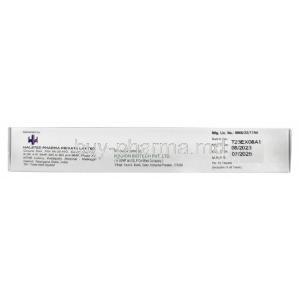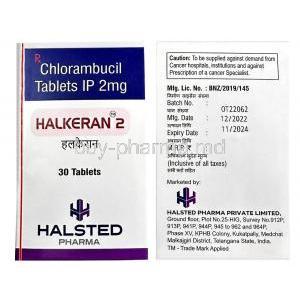Exemestane
- I. Introduction
- II. Uses of Exemestane
- III. How Exemestane Works
- IV. Off-label Uses
- V. Dosage and Administration
- VI. Composition
- VII. Storage
- VIII. Interaction
- IX. Side Effects
- X. Common Side Effects
- XI. Warning
- XII. Contraindication
- XIII. Careful Administration
- XIV. Important Precautions
- Administration to Elderly
- Administration to Pregnant Women and Nursing Mothers
- Administration to Children
- XV. Over Dosage
- XVI. Handling Precautions
I. Introduction
Exemestane is a known medication in the medical field that is used as a therapeutic agent for hormonal imbalances. It is taken orally—works by inhibiting aromatase. Doctors primarily prescribe it to women who have reached menopause as it plays a role in combating breast cancer that is responsive to estrogen receptors. Looking back at its history, Exemestane can be traced back to the 20th century when it was first introduced. Since then, it has undergone clinical evaluations and has proven to be an effective treatment for specific types of breast cancer. The continuous evolution of this medication showcases the community's dedication to refining treatment options.
II. Uses of Exemestane
Exemestane primarily serves as a treatment for early-stage breast cancer in postmenopausal women with hormone receptor-positive tumors. It is typically administered after two to three years of tamoxifen, resulting in a five-year total treatment period. The use of Exemestane provides benefits, including reducing the risk of breast cancer recurrence improving survival rates by targeting estrogen production, and optimizing overall therapeutic outcomes when used in conjunction with other treatments. In menopausal women, Exemestane is crucial in inhibiting estrogen synthesis in peripheral tissues while ovarian estrogen production ceases. This action helps prevent the growth of tumor cells that are sensitive to hormones.
References:
- Exemestane: Uses, Dosage, Side Effects, Warnings - Drugs.com
- Exemestane (Aromasin) - Breast Cancer Now
- Exemestane - NCI - National Cancer Institute
.
III. How Exemestane Works
Exemestane functions as an aromatase inactivator operating by binding to the enzyme's active site and permanently deactivating it. In terms, it precisely targets and disables the aromatase enzyme. As a result, Exemestane significantly reduces estrogen synthesis, leading to an 85% decrease in serum estrogen levels after administration. This is crucial because it effectively inhibits the production of estrogen that sustains estrogen tumors, providing them with much-needed nourishment.
IV. Off-label Uses
Overview of uses; While Exemestane is well known for its effectiveness in treating breast cancer, it also has a broader range of applications. These off-label uses include addressing conditions like gynecomastia and as a component in testosterone replacement therapy. Evidence supported off-label treatments; 1. They are managing gynecomastia in males. 2. Assisting with ovulation induction for women facing infertility. 3. Balancing testosterone to estrogen ratio in testosterone replacement therapy. Precautions to consider when exploring off-label use; It is essential to approach these alternative uses cautiously. While evidence supports their effectiveness, they may not have undergone the same level of scrutiny as approved indications. Therefore clinicians must exercise discretion and prioritize the needs and preferences of each patient.
References:
- What Does ‘Off-Label’ Use Mean for Medications? - GoodRx
- Exemestane Monograph for Professionals - Drugs.com
- Aromasin (exemestane) dosing, indications, interactions, adverse …
- Aromasin: Alternatives, side effects, dosage, and more - Medical News Today
- Exemestane: Uses, Dosage, Side Effects, Warnings - Drugs.com
.
V. Dosage and Administration
Recommended Dosages: the typical daily dosage of Exemestane is usually 25 mg for individuals dealing with hormone receptor breast cancer. Clinical evaluations have carefully determined this dosage to find the right balance between effectiveness and safety. Frequency of Administration; It is essential to take Exemestane to maintain therapeutic levels in your system. It should be taken daily, preferably at the same time each day, ensuring a consistent concentration of the medication in your bloodstream. Individualized Adjustments; While the mentioned dosage is a general guideline, individual variations may require adjustments. Factors such as liver or kidney issues, other medications being taken concurrently, or patients' unique reactions may necessitate dosage changes. Regular monitoring and guidance from healthcare professionals are crucial in cases.
VI. Composition
Exemestane's effectiveness lies in its compound, the key ingredient responsible for inhibiting the aromatase enzyme and reducing estrogen levels. In addition to the element, other components are included in its formulation. Microcrystalline cellulose is used to enhance the structure of the tablets, while sodium starch glycolate plays a role as a disintegrant. Magnesium stearate aids in the manufacturing process of the tablets. Exemestane comes in forms to suit individual preferences; tablets containing 25 mg of the active ingredient for easy oral consumption and a liquid form for those who prefer an alternative to pills.
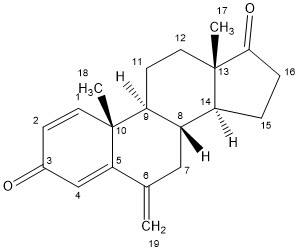
VII. Storage
To ensure that Exemestane retains its effectiveness, storing it under optimal conditions is essential. It is recommended to keep the medication dry away from direct sunlight and temperatures above 30°C. This will provide an environment for the stability of the drug. Considering the passage of time, even Exemestane is not immune to its effects. Generally, Exemestane's shelf life lasts a couple of years after its manufacture. However, if there are any changes in the appearance or integrity of the tablets, it is advisable to discard them. Here are some tips for maintaining the potency and efficacy of Exemestane; 1. Avoid storing it in environments with high moisture levels. 2. Keep it away from heat-emitting appliances. 3. Always make sure to secure the container cap after each use. Following these guidelines will help ensure that Exemestane remains effective throughout its shelf life.
VIII. Interaction
Like a conductor leading an orchestra, Exemestane can interact with medications in both harmonious and conflicting ways. It's essential to be aware of anticoagulants, specific anti-seizure drugs, and even other hormone therapies that may have an impact when taken alongside Exemestane. Additionally, harmless dietary supplements or herbs can unexpectedly affect its effectiveness. For example, St. Johns Wort has been known to alter how well Exemestane works. Therefore, you must have conversations with healthcare providers about any supplements you are taking.
Regarding the influence of alcohol and tobacco on Exemestane's efficacy, there is still uncertainty. However, it is advisable to exercise caution as alcohol consumption may exacerbate specific side effects, while tobacco use could potentially impact the drug's metabolism. As always, it is wise to proceed with prudence and seek guidance from healthcare professionals.
IX. Side Effects
An overview of the side effects; Exemestane, although it brings hope to many, can still have some unwanted effects. These effects can range from temporary inconveniences to more noticeable symptoms. It's essential to be aware of these consequences. Differentiating between severe side effects is crucial. Mild ones usually go away on their own with the need for intervention but severe manifestations require immediate medical attention. Patients are advised to understand this distinction for their safety.
X. Common Side Effects
Reported symptoms include hot flashes, joint and muscle pain, insomnia, and fatigue. Managing and reducing the side effects of Exemestane often involves taking measures. This can include making lifestyle changes considering medications or adjusting the dosage to make the treatment more comfortable for patients.
XI. Warning
Exemestane can occasionally worsen conditions, although this is rare. These conditions include osteoporosis, severe skin reactions, and significant liver abnormalities. Experience rashes, yellowing of the skin or eyes, persistent vomiting, or unusual bruising or bleeding while taking the medication. It may indicate underlying complications that require you to stop using it.
XII. Contraindication
Exemestane should not be given to patients who have a known allergy to Exemestane or its ingredients. Additionally, individuals with genetic conditions should avoid taking this medication. Allergic reactions that may occur include skin rashes, itching, swelling, severe dizziness, and difficulty breathing. These are the signs of an allergic response to Exemestane.
XIII. Careful Administration
There are things to think about when using Exemestane safely. Before starting the Exemestane regimen, it's crucial to disclose any medications you're taking and any underlying health conditions or allergies you may have. It's also wise to have health checkups while undergoing treatment to catch any potential complications early on. It's recommended to monitor your liver functions, bone density, and cholesterol levels while taking Exemestane.
XIV. Important Precautions
Before starting the treatment, initial evaluations are conducted, which include a review of the patient's medical history, a physical examination, and the necessary laboratory tests. These assessments provide a foundation for ensuring a safe therapeutic process. In cases where patients have liver or kidney conditions, adjustments may be required in terms of dosage or alternative treatment approaches. This highlights the importance of providing care based on individual patient needs.
Administration to Elderly
Dosage considerations; When prescribing Exemestane to individuals, it is essential to be more vigilant in monitoring their response due to the natural physiological changes that occur with aging. It is necessary to monitor any potential side effects in older patients as their unique physical makeup may lead to different profiles of side effects requiring careful observation.
Administration to Pregnant Women and Nursing Mothers
There are risks to the unborn baby and newborns if Exemestane is taken during pregnancy. It could lead to birth defects or miscarriages. Nursing mothers should also be cautious as the drug may be excreted in breast milk. If a woman becomes pregnant while taking Exemestane, it is advised to stop the treatment and receive counseling about the potential risks.

Administration to Children
The safety and effectiveness of Exemestane in patients is still not well understood. There is no substantial evidence to determine its safety and efficacy confidently. It is essential to exercise caution when considering using Exemestane in children. Age-specific dosage recommendations are not yet established due to research in pediatric patients. Consulting with oncologists is crucial, especially for cases where Exemestane may be considered.
XV. Over Dosage
Excessive consumption of Exemestane can lead to signs such as extreme tiredness, feelings of sickness, lightheadedness, and discomfort in the abdomen. When an overdose occurs, seeking medical assistance and receiving appropriate treatment is crucial while closely monitoring for potential complications.
XVI. Handling Precautions
Healthcare providers and caregivers must wear gloves when dealing with Exemestane to ensure the medication does not touch the skin during handling and administration.













